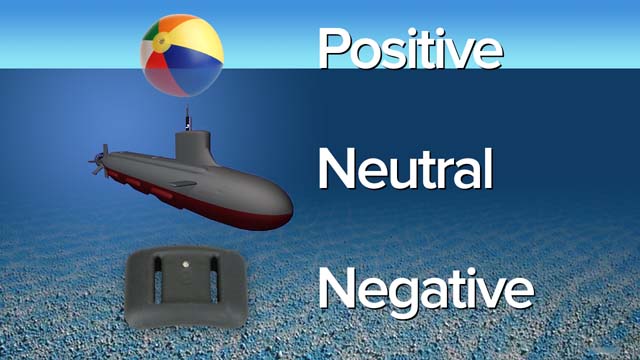Buoyancy

In this section, we discuss:
- Archimedes’ Principle
- Fresh Versus Salt Water
- What is Archimedes’ Principle?
- How does the difference in density between fresh water and salt water affect a diver’s buoyancy?
Archimedes’ Principle
Archimedes’ Principle states that any object wholly or partly immersed in a fluid is buoyed up by a force equal to the weight of the fluid displaced by the object. Simply stated, buoyancy is the force that causes objects to float.

You should remember the three states of buoyancy from your entry-level scuba class: positive, neutral, and negative.
- If an object is positive, it floats.
- If an object is neutral, it stays in the same place in the water column, neither sinking to the bottom nor rising to the surface.
- If an object is negative, it sinks.
According to Archimedes’ Principle, you can determine what weighs more, the object or the amount of water the object displaces, by observing its state of buoyancy.
- If an object is positively buoyant, then the weight of the water displaced by the object weighs more than the object.
- If an object is neutrally buoyant, then the weight of the water displaced by the object equals the weight of the object.
- If an object is negatively buoyant, then the weight of the water displaced by the object weighs less than the object.
Fresh Water versus Salt Water
The most important difference to divers between salt water and fresh water is its density. While temperature affects the density of both salt and fresh water, salt water is typically denser and heavier. This affects how much weight you will need.
Let’s say that you use the same gear regardless of whether you are diving in fresh or salt water. Even though you and your gear displace the same amount of water, the amount of salt water you displace weighs more than the same amount of fresh water. The denser salt water “pushes you up” or buoys you up with greater force. Hence, you need more weight in salt water to begin a descent than when diving in fresh water.

All other factors being equal — including equipment — smaller divers will typically need 2 kg/4 lbs more weight in salt water than in fresh. Larger divers may need as much as 3 kg/6 lbs more weight.
These figures are estimates; you can only determine the correct amount for you by performing an end-of-dive weight check. At a depth of 3-6 m/10-20 ft (safety stop depth), and with approximately 35-70 bar/500-1,000 psi remaining, a properly weighted diver should be able to maintain neutral buoyancy without having to fight to stay down or add air to his or her BC.
Bear in mind that exposure suit selection plays a significant role in proper weighting. Even though divers generally need more weight in salt water, a diver wearing a thick exposure suit could still need substantially more weight in fresh water than the same diver would in salt water if only wearing, say, a 3 mm wet suit.
Key Points to Remember
- Any object wholly or partly immersed in a fluid is buoyed up by a force equal to the weight of the fluid displaced by the object.
- Divers generally need less weight in fresh water than they do in salt water because fresh water is less dense.
Learn More on Wikipedia
